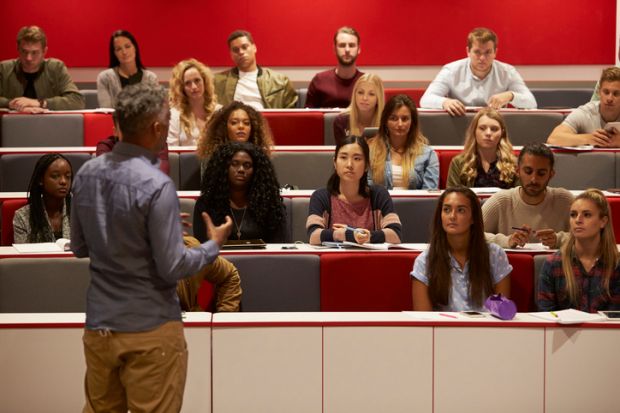Demographics could determine which universities revive large-scale in-person lectures once the defeat of Covid-19 makes them a viable proposition.
Australia’s Curtin, Murdoch and Victoria universities intend to permanently dispense with face-to-face lectures, particularly those involving gatherings of 100 or more people. But the University of Sydney has no such plans, according to deputy vice-chancellor for education Pip Pattison.
Professor Pattison said Sydney would host fewer lectures in the future. “But I don’t think there’s much of a will here to get rid of the lecture altogether,” she told Times Higher Education.
“A really good lecture is a fine thing. To take it out of the suite of options doesn’t seem wise. For a person who does it well, it’s very efficient because you can inspire hundreds of students at once.”
She said the university’s emphasis over the past half-decade had been on “more interaction in class, more collaboration, more experiential work and better digital resources so that people don’t waste class time talking about things they can read”. Experience acquired during campus lockdowns would accelerate the change, spawning a “more diverse set of designs for teaching” than in pre-pandemic times.
“There won’t be this formula of lectures plus tutes [tutorials], or lectures plus labs plus tutes, that we’ve had pretty universally across the entire suite of offerings. We’ll hopefully get to a point where we’re more thoughtful about the formats we use, and the reasons for using them.”
But Murdoch’s pro vice-chancellor for education, Kylie Readman, said lectures had a less assured future at universities with high proportions of socioeconomically disadvantaged or mature-aged students.
“Saying to someone: ‘Don’t work, put your kids in childcare, pay for parking to come and listen to me talk for two hours’ – that’s not a good-value proposition for someone who’s already thinking: ‘I’m the first in my family to come to university and I’m not sure this is right for me.’
“It’s great to have a lecture but if only seven people come to it, is that really the best use of a lecturer’s time? Is that the best use of our space? Is that the best use of our timetable?”
Professor Readman said student profile would largely determine which universities revived large-scale lectures. “Sydney has a completely different set of drivers to us, and a different set of expectations around how students will behave.
“Some [of our] students prefer face-to-face lectures. They like the structure. But they’re not the majority, and those people can also access other forms of learning. People who have caring or work responsibilities can’t.”
Class size could also determine the fate of face-to-face lectures. Professor Readman said Murdoch had drawn the line at groups of 100 people. “That’s the number our safety manager said he felt comfortable with.”
Professor Pattison said that while Sydney’s lecture theatres had capacity for about 500 students, online lectures could handle twice as many – although larger groups necessitated better systems for handling students’ questions. “You might need someone to help you [answer questions] after class if you don’t get to them all.”
While remote lectures also offered “valuable” savings in electricity and space, she said students were still drawn to campus for the company and atmosphere. “They’ll even come and listen to lectures online, in the room next door.
“I think we’ll see a lot of conversions of lecture theatres into other kinds of student spaces – multi-tiered group work or quiet study spaces. There’s going to be increased demand for informal learning space and reduced demand for lecture theatres.”
Victoria University, which has committed to small-group learning as part of its “block teaching” approach, said Covid-19 had accelerated the conversion of its lecture halls into informal learning spaces.
The associate provost of teaching and learning, Trish McCluskey, said the pandemic had enabled builders to “get stuck in” to their work. “Trying to get renovations done when students are on campus is a nightmare.”
Edith Cowan University has promised face-to-face delivery this year and says size will not be a factor. “We are committing to on-campus teaching for the 2021 academic year,” said the deputy vice-chancellor for education, Angela Hill. “This includes lectures, workshops and tutorials.”
She said the emphasis would be on collaborative learning in both large and small groups. The university was investing in a “new generation” of learning spaces to cater for both sizes, at the library in the main Joondalup campus – where building is under way over the summer break – and in the new City campus scheduled to open in 2025.




